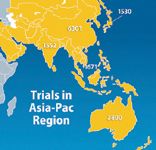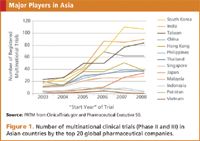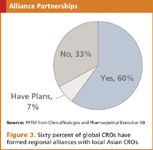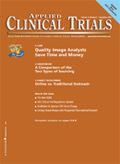Asia-Pac Grows With China Focus
The status of the CRO industry and doing business in the most recently emerged of the Asia-Pac regions.
A review of the press releases being issued by companies in the clinical trials space for the first half of the year, a clear trend toward Asia—and specifically toward China—is noticeable. While India gained ground in the Asia Pacific region for years and has moved away from emerging to established, and Japan is clearly a different and entrenched Asian market, China continues its emerging status with an uptick in activity.

IMAGE SOURCE/IMAGE SOURCE/GETTY IMAGES/CLINICALTRIALS.GOV
Specifically, those companies and their activities in China include and are not limited to:
- Parexel announced two new locations in Chengdu and Guangzhou, China. The CRO already has 17 other locations in Asia-Pac.
- CRO Chiltern announced new offices in Australia and Singapore, building upon an existing operation in India.
- i3 acquired ChinaGate, a CRO based in Shanghai, to capitalize on its knowledge of the Chinese regulatory authority, the SFDA.
These are only recent samplings. Just keyword search "Asia" at our Web site www.appliedclinicaltrialsonline.com to find releases from other major CROs, service providers and labs to determine that AsiaPac and, in particular China, are at the fore. There are reasons for this growth in all areas of pharmaceutical development, from discovery through to commercialization. The first piece was the emergence of pharmaceutical companies establishing R&D in China when it joined the World Trade Organization in 2001. It reorganized its drug regulatory systems under the State Food and Drug Administration (SFDA) in 1998, with many regulations emerging post 2004.
The next piece is significant investment by the Chinese government. By 2020, China is targeting an investment of 2.5 percent of its GDP into pharmaceutical R&D, according to published reports.
However, is company movement any gauge by which to uncover the true clinical trials market? How many trials, really, are going to China and the rest of Asia? And what is the status of CROs and pharmaceutical sponsor relationships in Asia and China?
At the IIR Partnerships in Clinical Trials meeting in April, a session titled "Sourcing to Low Cost Regions: Panacea or Piece of the Puzzle?" featured executives from Eli Lilly, Sepracor, Eisai, Amgen, and CRO PSI, who offered their take on the emerging markets. All sponsors noted current increases in trials being conducted in these markets, and anticipated growth in the emerging areas. Specifically, Graeme Currie, PhD, and Vice President, Clinical Operations, Sepracor noted currently less than 10 percent of subjects came from the emerging regions for its studies. However, he anticipated this to increase 30 percent to 40 percent depending on therapeutic area, within the next two to three years.
Similarly, Mitchell Katz, PhD, Vice President, Global Clinical Development at Eisai, noted a shift to the emerging regions from the United States. This was being achieved both through internal and CRO resources.
A representative from Amgen reported 29 percent of its trials being conducted currently in emerging regions, with an increase of 5 to 10 percent and its first study in China this year.
A recent survey conducted by PRTM, a management consultancy with locations in Asia, Europe, and the United States, titled "Trends in Asia Clinical Outsourcing." The survey featured an analysis of Asian trials by country from 2003 to 2008, which similarly reflects the increase in trials mentioned by the pharmaceutical executives.

Figure 1. Number of multinational clinical trials (Phase II and III) in Asian countries by the top 20 global pharmaceutical companies.
Benefits for conducting trials in emerging regions noted by the executives at the IIR Partnerships included speed of recruitment, access to naïve therapeutically-treated subjects, and reduced costs per participant.
According to the PRTM survey, low cost for trials was not the dominating factor for conducting a clinical trial in Asia. Their survey of pharmaceutical and CROs in the United States, EU, and Asia showed those reasons varied according to the country.

Figure 2. Access to patients ranked in the top two in all of the surveyed nations.
However, the reciprocal challenges include timing of regulatory hurdles, great variability of CRO expertise, and price quotes for work in those regions, and questions surrounding data quality.
Currie reported that it was difficult to find a truly global CRO with equal capabilities in each of the major regions. He noted the vastly different levels of experience, with a lack of a globally consistent approach.
Specific to China, Katz said that in the Asia Pacific, not including India, the CROs were struggling with experience and employee retention.
Last but not least, Currie mentioned the need to use data that had a hard clinical endpoint—not subjective—when conducting in the emerging regions. A subjective endpoint leaves the standard of care for that country open to interpretation; regulatory concern; and data distortion, should it trend in an opposite direction from the rest of the data.
Currie is not alone in data concerns. The overall quality of trials data in Asia—outside of India, Japan and South Korea — is perceived to be inferior to the West according to PRTM. Especially true of China and Taiwan.
Getting to China and back
There are approximately 138 CROs in China, according to a Chinese based consultancy. Meanwhile, the poster child for CRO success in that country, publicly-traded WuXi PharmaTech (which is technically incorporated in the Cayman Islands), at press time had just learned it would not be acquired by Charles River Labs for $1.6 billion after all. Charles River executives caved to stockholders, who weren't enamored with the premium to be paid vs. the company's belief that the purchase would create a fully integrated, global early-stage CRO, garnering operating income between $20 million and $30 million.
WuXi's pharmaceutical services span preclinical through commercialization, offering bioanalytical analysis, formulation development, stability studies, and product manufacture in Phase I through Phase III areas. It also offers a host of discovery and other development services. WuXi has had revenue growth rates exceeding 40 percent in the past three years. It has offices in Shanghai, Tianjin, Jiangsu, and in the Unites States in Georgia, Minnesota, and Philadelphia.

Figure 3. Sixty percent of global CROs have formed regional alliances with local Asian CROs.
The PRTM survey noted "Although multinational CROs continue to grow in size and influence, major pharmas are now working hard to blend the best of both worlds—seeking ways to link the operations of local Asian CROs with those of their global CROs in the region." CROs themselves also are actively seeking out those local CROs to gain expertise on the landscape there. According to its survey, the multinational pharma sponsors operating outside of Japan use a combination of local and global CROs for varying outsourced functions.
PPD's own presence in China helps illustrate one strategy that CROs use for entering the Asian market. At the IIR conference in April, William Sharbaugh, COO of PPD, told Applied Clinical Trials that specifically in China, it has central laboratories in Beijing and Singapore acquired via BioDuro; a vaccine clinical research center that opened in April in Taizhou, China; a drug discovery acquisition in Beijing; and it acquired Excel PharmaStudies, a CRO, for a presence in Beijing, Chengdu, Guangzhou, Shanghai, and the Jiangsu Province. "We got in ahead of the curve and we want to be trusted there—for both our clients in North America and Europe going into China and when Chinese pharmaceuticals want to take their products to these traditional markets," said Sharbaugh.
Recently, i3 acquired ChinaGate, a CRO that has helped bring 450 medical and consumer health products to its market. ChinaGate will integrate with i3 Research, and maintain its existing executive team. At DIA, Applied Clinical Trials met with Tracy Tsuetaki, OD, President, i3 Research, who outlined the goals of the acquisition. "We had staff within China, but this is our first acquisition of a company in China," said Tsuetaki. "They have the knowledge of the marketplace, and an understanding of the procedures of the SFDA, which is crucial."
Specifically SFDA
On the topic of the SFDA, Sharbaugh said that the regulatory time frame in China is still on the long side, roughly eight to 12 months to get approval. He noted that the SFDA is very open to addressing this and shortening those time lines. "When that happens, it [clinical trials] 'will accelerate," said Sharbaugh. He noted collaborations taking place among representatives from industry associations ACRO and PhRMA and the FDA and SFDA to discuss shortening regulatory approval time lines in China.
Tsuetaki has also met with the SFDA in China, which wants to have greater understanding of the various therapeutic areas for the drugs in development, and scrutinizes the data on drugs that have already been approved in other countries. "The SFDA is very interested in the safety profiles in other countries," said Tsuetaki.
Parexel Chief Operating Officer Mark Goldberg, MD told Applied Clinical Trials at the DIA Annual Meeting that another responsibility that the SFDA has is accrediting investigators in China. "The SFDA is interested in supporting the industry and seeing that the number of accredited investigators increases," said Goldberg. "Furthermore, the SFDA would like to see accredited sites developed outside of the existing popular locations for clinical trials in China, such as Beijing and Shanghai. We expect that the SFDA will undertake more general and advanced GCP training of sites across China to encourage more multinational clinical trials in the country. Through our close collaboration with sites in China we have been involved in providing ICH-GCP mentoring to investigators. With our newly established offices in Guangzhou and Chengdu, Parexel has extended its reach to additional locations."
In the immediate future, the large global CROs will continue to stake their ground in Asia, and China as the last frontier. Competition to ally or acquire local CROs, as well as competition with other CROs to gain the outsourced trials in China from the sponsor community will continue. The sponsors at IIR were quite candid on what they wanted from their CROs, and the survey from PRTM supports their statements. Most are having the same experiences and there are no outliers. It appears the onus is on the local regulatory authorities, as well as the CROs, to see how quickly the clinical trials in Asia can grow.

Improving Relationships and Diversifying the Site Selection Process
April 17th 2025In this episode of the Applied Clinical Trials Podcast, Liz Beatty, co-founder and chief strategy officer, Inato, discusses a number of topics around site engagement including community-based sites, the role of technology in improving site/sponsor relationships, how increased operational costs are impacting the industry, and more.